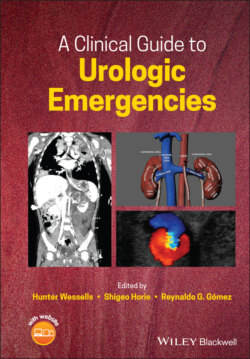Читать книгу A Clinical Guide to Urologic Emergencies - Группа авторов - Страница 22
Predictors of Failure of Non‐Operative Management in Blunt Renal Trauma
ОглавлениеOf patients with blunt trauma that are managed non‐operatively, some will ultimately require intervention. One series evaluated 154 patients (74.8%) with grade IV and V blunt renal trauma, who were initially managed non‐operatively, with a non‐operative management failure rate of 7.8% [62]. The vast majority of the patients who failed non‐operative management did so because of their kidney injury and none of these patients had complications as a result of delayed operative management. The mean time to failure was just over 24 hours and the majority (83.3%) failed due to hemodynamic instability. Independent predictors based on multivariate analysis found that those who were older than 55 years of age or who were injured as a result of a motor vehicle collision were more likely to fail non‐operative management.
Patients with a devitalized parenchymal segment were more likely to require delayed surgical intervention in a series of grade IV and V blunt renal injuries [46]. Of 40 patients with grade III–V blunt renal injury initially managed non‐operatively, the risk of delayed nephrectomy in three was associated with grade IV injuries and secondary hemorrhage which necessitated intervention [8].
